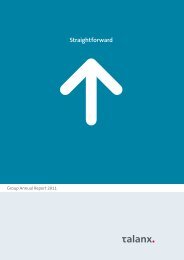Values
Values
Values
You also want an ePaper? Increase the reach of your titles
YUMPU automatically turns print PDFs into web optimized ePapers that Google loves.
Company | Group Management Group Financial | Corporate Governance | Report of the | Boards/Mandates | Additional Information<br />
Report Statements Supervisory<br />
Board<br />
Income Statement<br />
Statement of Comprehensive Income<br />
Balance Sheet<br />
Cash Flow Statement<br />
Statement of Changes in Equity<br />
Notes<br />
Inventories<br />
Inventories, including raw materials and supplies, fi nished goods<br />
and work in progress as well as merchandise, are recognized at<br />
the lower of historical cost and net realizable value at the end of<br />
the year. Similar inventories are reported at average cost less cost<br />
to sell or using the FIFO (fi rst-in, fi rst-out) method. Inventories<br />
originating from intragroup suppliers are adjusted to eliminate<br />
intercompany profi ts and are measured at the Group’s manufacturing<br />
cost.<br />
Inventories carried at cost are reviewed for possible writedowns<br />
at the end of the year. Net realizable value is applied<br />
for this purpose as of the balance sheet date. Net realizable<br />
value is defi ned as the estimated sales price less expected costs<br />
to complete and estimated selling expenses. A write-down is<br />
recognized if the net realizable value of an item of inventories<br />
is lower than its historical cost. Write-downs are reversed if the<br />
circumstances causing their recognition no longer apply. Th e<br />
new carrying amount then represents the lower of historical<br />
cost and adjusted net realizable value. Th e consumption of<br />
inventories is reported in the income statement in the cost of<br />
materials or changes in inventories.<br />
In addition to raw materials and supplies, fi nished goods,<br />
work in progress and merchandise, inventories include all<br />
short-term fi lm, television and similar rights that are intend-<br />
Bertelsmann Annual Report 2009<br />
ed for broadcast or sale within the Group’s normal operating<br />
cycle (i. e., one year). In particular, this includes fi lms and TV<br />
shows currently in production, co-productions and acquired<br />
broadcasting rights. Th e carrying amount of such items at the<br />
balance sheet date is as a rule the lower of historical cost or<br />
net realizable value.<br />
Th e amortization of fi lm and television rights starts from the<br />
date of initial broadcast and depends either on the number of<br />
planned broadcasts or the expected revenues. Th e broadcastbased<br />
amortization of fi lm and television rights is performed<br />
as follows:<br />
• Entertainment programs, such as soap operas, documentaries<br />
and sports, quiz or music programs are written off in full at the<br />
initial broadcast date;<br />
• 50 percent of the carrying amount of children’s programs and<br />
cartoons is written off at each of the fi rst two broadcast dates;<br />
• Th e consumption of cinema productions, TV feature fi lms and<br />
series also spans a maximum of two broadcasts: 67 percent of<br />
the value is consumed upon the fi rst broadcast, the remaining<br />
33 percent upon the second broadcast.<br />
For in-house productions, consumption is reported in the<br />
income statement under changes in inventories, while the consumption<br />
of acquired rights is reported in the cost of materials.<br />
95
















